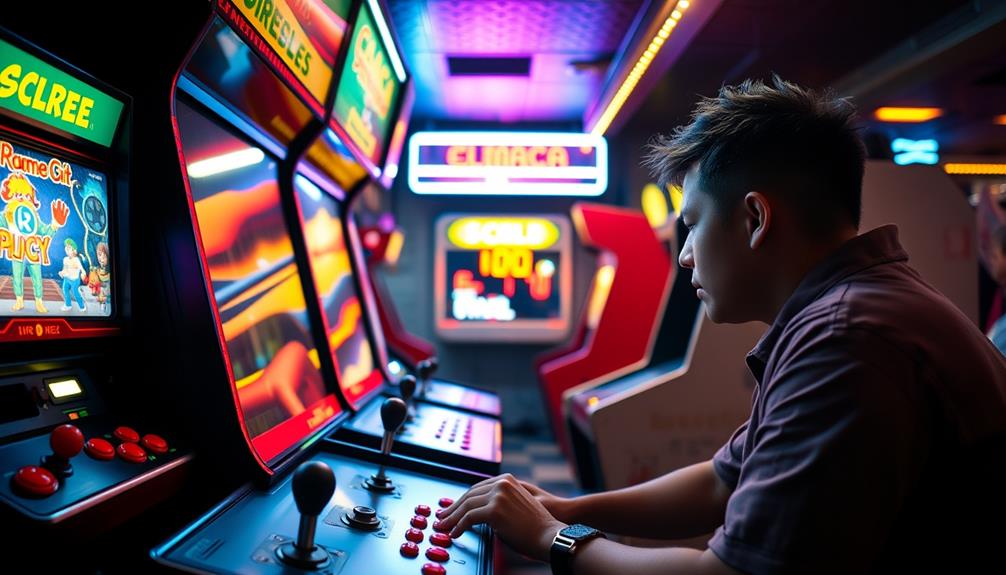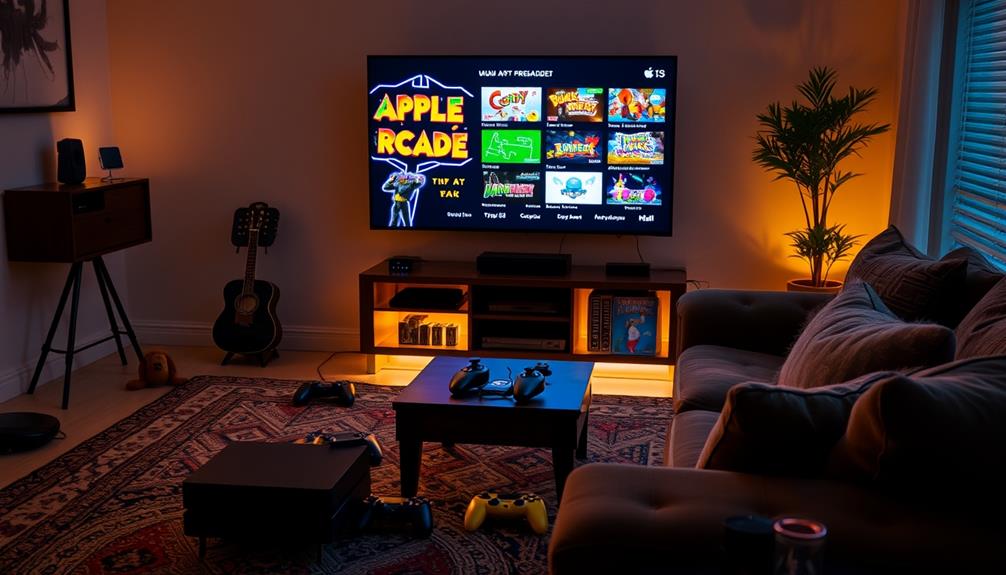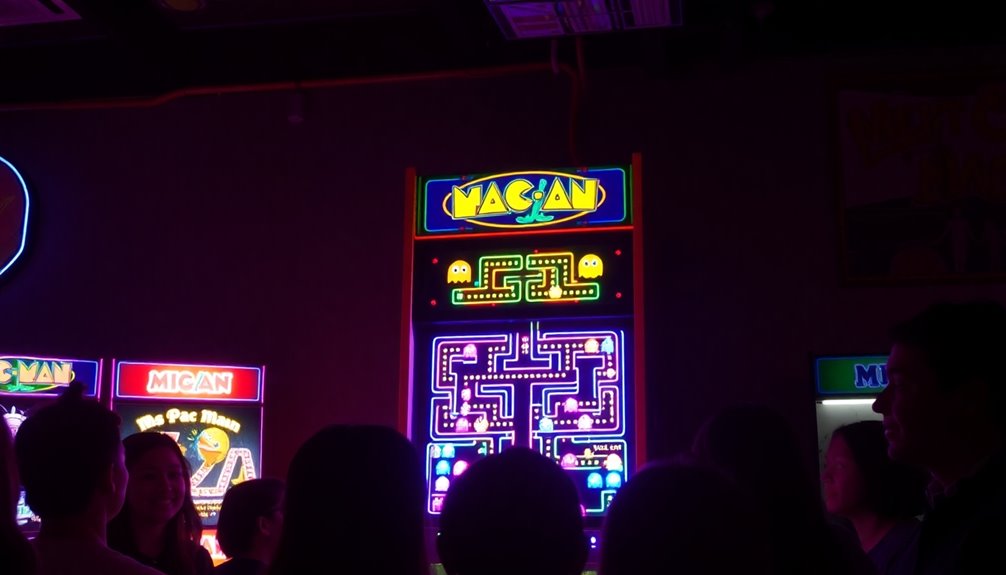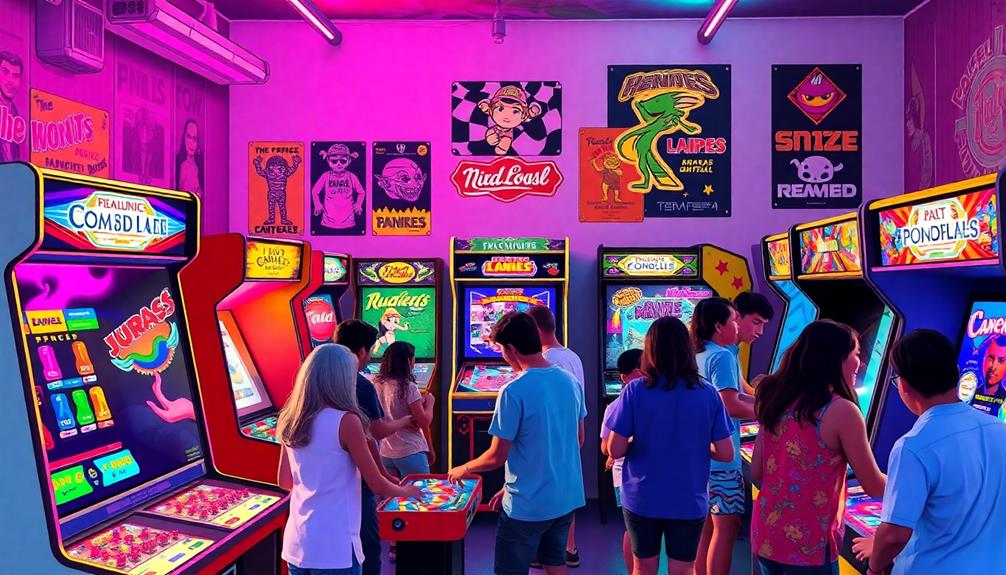Arcade games presented a challenge due to their design that motivated players to continue playing. Incorporating features like one-hit deaths and limited lives, these games encouraged players to invest more coins for a shot at success. Games such as Galaga thrived on this competitive nature, generating approximately 50 cents every two minutes. The excitement of competing and the drive to achieve high scores kept players engaged, with simple gameplay mechanics ensuring accessibility for all. This combination of captivating gameplay and skill development established a cycle that etched these challenging games into memory. Surprisingly, the evolution of arcade game graphics also contributed to their difficulty over time. As visuals became more realistic and immersive, players found themselves drawn in by the impressive imagery, making it harder to focus solely on gameplay. The complexity of the graphics also resulted in slower response times, leading to challenges in timing and accuracy. Despite these obstacles, the fascination with evolving arcade game graphics continued to draw players back for more.
Key Takeaways
- Arcade games were designed with high difficulty to maximize player engagement and encourage repeated coin insertion for revenue growth.
- Mechanics like one-hit deaths and limited lives reinforced the challenge, compelling players to invest more time and coins.
- The competitive nature of high scores fostered rivalry, motivating players to improve their skills and return for further challenges.
- Technological constraints, such as low-resolution graphics and clunky controls, added to the difficulty and required players to develop mastery over time.
- Nostalgia for challenging gameplay and community connections created a cultural impact, encouraging players to embrace the difficulty of arcade games.
Economic Model of Arcade Games
The economic model of arcade games hinges on a simple yet effective principle: the harder the game, the more money it can make. By integrating high difficulty levels, game designers guaranteed that players would keep inserting coins in a bid to conquer challenging gameplay. This strategy directly correlates with coin insertion frequency, as prolonged attempts at difficult games lead to more revenue for arcade operators.
Games like Galaga showcased this model perfectly, generating around $0.50 every two minutes. With each loss, you'd feel the urge to try again, not just for the fun but to prove your skills. Additionally, this model parallels the excitement found in best rated pinball machines, where advanced technology and design keep players engaged and keen to play.
Operators capitalized on this drive by adjusting difficulty settings to keep players engaged and encourage a higher turnover. The more challenging the game, the more likely you'd drop in another coin for another shot at victory.
This pay-per-play model demanded that every game design justifies its cost, leading to intentionally punishing mechanics that kept you coming back for more. Ultimately, the economic model of arcade games thrived on your willingness to face the challenge, guaranteeing that each play was a potential revenue booster for arcade operators.
Intentional Difficulty Design

When you step up to an arcade machine, you quickly realize that the high difficulty isn't just for fun; it's a strategy to keep you engaged and coming back for more.
Developers designed these challenges to maximize revenue, making every lost life feel urgent and your next quarter feel necessary.
Best Arcade Machines showcase how this design philosophy has evolved over time.
This intentional difficulty not only tests your skills but also fuels the desire to improve and conquer the game.
Revenue Maximization Techniques
While many players enjoy the thrill of conquering challenges, arcade game designers intentionally crafted high difficulty levels as a strategy to maximize revenue. By implementing punishing mechanics like one-hit deaths and limited lives, they encouraged you to keep inserting coins in hopes of overcoming obstacles. This approach mirrors how understanding common financial terms can influence budgeting decisions. The goal was clear: the longer you played, the more money you'd spend on arcade machines.
Game operators could adjust difficulty settings, helping to maintain the delicate balance between player frustration and engagement. This guaranteed that machines remained profitable, maximizing coin usage during each gaming session.
Historical examples highlight this strategy; for instance, Galaga earned $0.50 every two minutes, showcasing the direct correlation between high difficulty and increased earnings for arcade owners.
Designers aimed to create an environment that both challenged you and sparked your competitive spirit. They knew that if you felt just frustrated enough, you'd be tempted to try again, pushing your score higher and investing more money.
Ultimately, the combination of high difficulty levels and clever design guaranteed that arcade games not only entertained but also served as a lucrative business model, driving revenue maximization in the gaming industry.
Player Engagement Strategies
Arcade gaming flourishes on player engagement strategies that leverage intentional difficulty design to keep you hooked. Game developers crafted these experiences with high levels of difficulty to encourage you to insert more coins, maximizing your time spent playing.
With mechanics like one-hit kills and limited lives, the challenges compel you to try again, reinforcing the cycle of engagement. As AI technologies evolve, understanding AI ethicist jobs can also offer insights into how ethical considerations can shape user experiences across various digital platforms.
Operators also adjusted the difficulty settings to control how long you'd stay at the arcade. They aimed for a balance that promoted profitability while maintaining an enticing challenge. As you faced increasingly tough levels, the thrill of competition and the lure of achieving high scores drove you to invest even more time and coins.
Classic arcade titles often featured addictive gameplay elements, like escalating difficulty and environmental hazards, designed to enhance player retention.
These elements not only tested your skills but also created a sense of accomplishment when you overcame the challenges. In this way, the intentional difficulty design became a key component of game design, ensuring that every session felt rewarding, keeping you engaged and enthusiastic for just one more attempt.
High Score Competition

When you step up to an arcade machine, the thrill of competition pulses through the air as you eye the leaderboard.
The nostalgia of classic arcade games, with their steep learning curves and challenging gameplay, adds to the excitement and allure of trying to beat high scores. Achieving a top score isn't just about bragging rights; it's a status symbol that showcases your skill among peers.
This drive to climb the ranks keeps you coming back for more, pushing you to master the game and outshine your friends, much like the silly tantrums often occur during family photoshoots that create memorable moments.
Thrill of Competition
The thrill of competition in arcade games pulls players into a world where high scores reign supreme. You find yourself driven not just to complete the game but to rack up points, pushing against the challenging mechanics and high difficulty.
Players would often return to the arcade, fueled by the desire to improve their scores and outshine others. This competitive spirit is reminiscent of the dynamics seen in astrological compatibility, where players also endeavor for connection and engagement with others.
Here's what makes the competition so engaging:
- Mastery of Skill: Games like "Galaga" and "Pac-Man" challenge you to refine your techniques.
- Community Connection: You share strategies and celebrate others' achievements, building camaraderie.
- Repeated Play: Each game session becomes an opportunity to better your high score, despite how hard the games were.
- Bragging Rights: Achieving a top score feels rewarding and often leads to friendly rivalries.
- Leaderboard Aspiration: Climbing the ranks becomes not just a personal goal but a community event.
These elements create an environment where the thrill of competition thrives, encouraging you to hone your skills and engage with others in pursuit of that elusive high score.
Leaderboard Status Symbol
High scores became a status symbol in the arcade scene, elevating the competition and igniting a fierce desire to dominate the leaderboard. When you managed to rack up an impressive score, you didn't just celebrate your achievement; you also left your initials on the leaderboard, marking your territory and showcasing your skills to everyone around you.
This sense of pride and recognition fueled the competitive nature of arcade gaming, pushing players like you to return again and again. The thrill of achieving a personal best could be likened to the joyous feelings evoked by a song like Blue Skies and Lemonade, where every victory felt like a radiant moment of triumph.
Games such as "Space Invaders" and "Pac-Man" popularized high score competitions, creating an environment where rivalry thrived. With each play, you aimed not only to beat your previous score but also to surpass your peers.
The thrill of competing for the top spot became addictive, driving you to improve your gameplay and master the challenging mechanics. As you battled for leaderboard supremacy, you contributed to the arcade's revenue, ensuring that these gaming havens continued to flourish.
In this relentless pursuit of high scores, the difficulty of the games only added to the allure, making every victory that much sweeter and every loss an opportunity for growth.
Accessibility and Mastery Balance

Many arcade games strike a careful balance between accessibility and mastery, making them enjoyable for players of all skill levels. Developers understood that to attract new players, games needed to be easy to pick up while still offering depth for seasoned veterans.
This balance is a core principle of game design, creating pathways for skill progression that keep players engaged. Data-driven strategies yield measurable results, similar to how game designers analyze player behavior to enhance gameplay experiences.
Here are some key aspects of this balance:
- Approachable Gameplay: Titles like "Pac-Man" and "Donkey Kong" welcomed beginners with simple mechanics.
- Increasing Complexity: As you progress, challenges ramp up, pushing you to refine your skills.
- Rewarding Experience: High scores and achievements motivate you to replay and improve.
- Skill Development: Mastering difficult sections feels rewarding, reinforcing your motivation.
- Endless Engagement: This design encourages repeated playthroughs, keeping the experience fresh and exciting.
In essence, the interplay between accessibility and mastery in arcade games guarantees that everyone can find enjoyment, whether you're just starting or aiming for that top score.
This thoughtful approach to game design creates a fulfilling gaming experience that stands the test of time.
Addictive Gameplay Mechanics

Addictive gameplay mechanics are a hallmark of arcade design, drawing players into a cycle of challenge and reward. These mechanics make games feel irresistible by creating a challenging experience that encourages repeated attempts. You'll often find yourself facing one-hit deaths and complex enemy patterns, which keep you motivated to hone your skills and try again.
As you endeavor for improvement, the thrill of achieving high scores and entering your initials on the leaderboard fosters a competitive spirit. This environment makes you more likely to insert additional quarters, enthusiastic to see how far you can go.
The game would often start with easier phases, lulling you into a false sense of security before ramping up the difficulty. This escalation keeps you hooked, as you seek to conquer tougher challenges.
Psychological triggers play a significant role in this design. The excitement of overcoming difficult tasks and the prospect of progress reinforce addictive behaviors, compelling you to return for more.
Fundamentally, these addictive gameplay mechanics transform a simple gaming session into a compelling quest for mastery, ensuring you keep coming back for just one more round.
Technological Constraints of the Era

The technological constraints of the era shaped the design and difficulty of arcade games in significant ways. Limited hardware capabilities meant that game developers had to work within tight boundaries, which often resulted in tougher gameplay. This aligns with the principles of content relevance and authority, as developers prioritized challenge over accessibility to engage players.
Here's how those constraints influenced the challenge you faced:
- Low resolution graphics: These restricted the complexity of visuals and level design, making navigation tougher.
- Clunky controls: Hardware limitations led to unresponsive character movements, frustrating your attempt to maneuver.
- No save features: The absence of checkpoints meant you'd to replay entire levels, ramping up the difficulty after each failure.
- Limited storage capacity: With fewer levels to explore, designers compensated by increasing difficulty, leaving you with a challenging experience.
- No patch support: Bugs and glitches stayed in the games, adding another layer of challenge as you navigated through unexpected issues.
These technological constraints pushed arcade games to be more demanding, ensuring that each session required focus and skill. You weren't just playing a game; you were battling the limitations of the machines themselves.
Cultural Impact and Nostalgia

Arcade games sparked a cultural revolution in the 1980s, transforming casual gaming into a communal experience where players flocked to local arcades to chase high scores and share their triumphs over difficult challenges. This cultural phenomenon not only created friendships but also fostered a competitive spirit that thrives to this day.
The nostalgia for these challenging games resonates deeply, as many recall the thrill of overcoming tough levels and the camaraderie built in arcades. You likely remember those moments when you finally conquered a notoriously hard game, and how that sense of achievement felt.
Here's a quick look at the cultural impact of arcade games:
| Aspect | Description | Example |
|---|---|---|
| Community Building | Players gathered to compete and share stories | Local arcade tournaments |
| Nostalgia | Fond memories associated with challenging gameplay | Reminiscing about "Nintendo Hard" |
| Modern Influence | Inspired indie developers to recreate this feeling | Retro-themed games |
From tournaments to online forums, the legacy of difficult arcade games continues to inspire. You can see how this nostalgia has shaped modern gaming, making it clear that challenging gameplay will always hold a special place in our hearts.
Evolution of Gaming Difficulty

Gaming difficulty has evolved considerably over the decades, shaped by player expectations and industry innovations. In the early days, arcade titles were infamous for their punishing difficulty levels. You may recall how games like Galaga drew you in, demanding your quarters while pushing your skills to the limit.
The challenge of these games often mirrored the immersive experiences found in AI-Powered Virtual Reality in E-Learning, where engagement and skill mastery are key to progression.
Back then, players faced challenges that included:
- No save progress: You'd to replay entire games upon failure.
- "Nintendo Hard" games: Titles that featured one-hit deaths and required memorization.
- Skill development focus: Difficulty was a measure of mastery and perseverance.
- High stakes: Operators designed games to maximize coin insertion for revenue.
- Cultural shift: Overcoming obstacles was celebrated, creating a community around shared struggles.
As the gaming landscape transformed, player expectations shifted. Nowadays, many games balance accessibility and challenge, often leading to easier gameplay experiences, especially when compared to those retro arcade titles.
While you might appreciate the thrill of overcoming tough challenges, it's clear that today's games cater to a broader audience, reflecting a shift in how we define difficulty in gaming.
Frequently Asked Questions
Why Were Old Arcade Games so Hard?
Old arcade games challenged you with tough mechanics and limited resources. You had to master each level without safety nets, facing intense competition. It was all about skill, pushing you to improve and keep playing.
Why Did Arcade Games Lose Popularity?
Arcade games lost popularity as home consoles offered easier gameplay, save features, and diverse genres. You shifted to personal devices for lower costs and online experiences, leaving arcades struggling to compete in the changing gaming landscape.
What Is the Hardest Arcade Game of All Time?
When it comes to the hardest arcade game of all time, you can't miss "Ikaruga." Its bullet-hell mechanics and polarity-switching demand your utmost skill, making each victory feel like you've truly moved mountains.
Why Were NES Games Hard?
NES games were hard because they challenged your skills with limited lives and complex levels. You had to memorize patterns, face punishing mechanics, and embrace trial-and-error gameplay, making victories feel rewarding and hard-earned.
Conclusion
In the neon-lit jungle of arcade games, difficulty wasn't just a challenge; it was the heartbeat of the experience. These pixelated titans pushed players to their limits, blending frustration and exhilaration into an addictive dance. As you chased high scores, every hard-earned victory felt like conquering a dragon. Today, that nostalgic thrill lingers, reminding us that sometimes, the hardest paths lead to the most rewarding adventures. So, grab your joystick and embrace the challenge—it's part of the magic!








